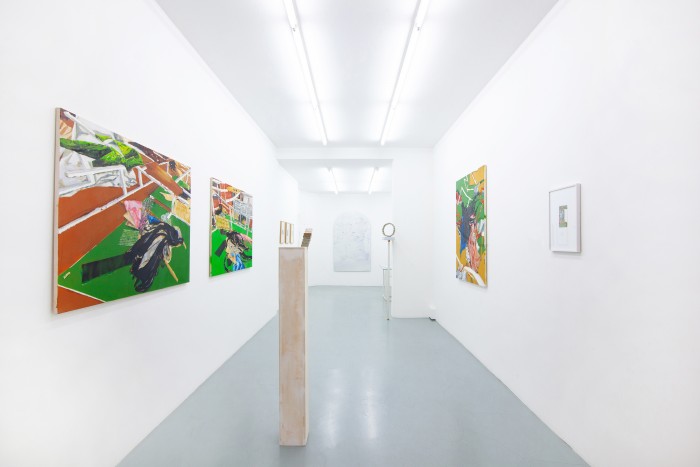INSTRUCTIONS POUR COUPER LES FICELLES – ALBERTA PANE
GAYLE CHONG KWAN – GAETANO CUNSOLO – LÉONARD MARTIN – JOÃO VILHENA
The stage of the theatre is empty. Marionettes and scenery remains lie on the ground. Their strings, still visible, have been cut.
“Instructions pour couper les ficelles”* (Instructions to cut the strings) brings together four artists from different backgrounds whose practice often reveals what hides behind the artwork’s production, what is offstage.
In Gayle Chong Kwan’s photographs of sets designed in her studio, in the João Vilhena’s skillful drawings (Dessins habiles), in the stairs of Gaetano Cunsolo, in the paintings of Léonard Martin we can recognize the backstage, the entrails of the work which are normally hidden, ignored, out of sight of the spectators.
The White Oval Arc and the Blind vistas series by Gayle Chong Kwan evoke a lunar landscape. This London based artist explores imaginal travels using recycled materials.
White Oval Arc opens a door towards a made-up world, conceived in homage to Méliès and his Trip to the Moon. The cut paper weaves an infinite scenography where mechanism remains visible.
Get on the pulpit is a series of small sculptures in the shape of a staircase: this architectural device from which all perspectives radiate. In his work, Gaetano Cunsolo deconstructs perspectives. When he decides to twist a staircase until it takes a circular shape, perspective becomes a confusion of vanishing lines where references tend to get lost. In these sculptures, the staircase is no longer an ascending device. It is perhaps an invitation to rethink the supports that perilously guarantee the established order of powers.
Moreover, Léonard Martin often uses photographs of sets built in his studio as a starting point for his paintings. For him, a painting is an instant taken from the images that constantly flow and flee. It is a way to linger over an image and give it substance and matter. In his animated films, in his installations and large-scale sculptures, characters do not hide their creature-like condition. And they confront without fear the great names of art history and literature such as James Joyce, Paolo Uccello, or Murasaki Shikibu. Shikibu is a Japanese writer and poet from the 11th Century, author of The Tale of Genji, a story that inspired the Variations Genji series.
In the quietness of these paintings, we can see loose threads, abandoned fabrics that seem to come to life in a landscape showing the inertia of a world the artist conceives in permanent motion.
João Vilhena accurately draws the edges of old postcards. Like small windows, these cards show erotic scenes that hide many possible stories. Yet his photorealistic drawings are strewn with vertiginous imperfections. The artifice understood as this clever process intended to create an illusion is here overthrown by an endless game of tracks with no specific goal. João Vilhena’s drawings thus reveal the flaws of a fiction destined to fall, to assume emptiness and rebound into uncertainty.
In 1969 Julio Cortázar publishes the sequel of his “Instructions on How to Climb a Staircase”**. In this text, he writes a guide to climb a staircase upside down. The nature of a user manual is treated in a parodic way following a series of disconcerting instructions.
During the exhibition, under the gaze of Cortázar’s instructions, each work could be a step to follow from a non- prescriptive and non-linear manual.
Once cut, the strings no longer connect the work and its author. It is with the action of the viewer that they catch their breath, that the scenery is rebuilt and moved by the thrill of newperspectives.
- Ananay Arango
* The expression “tirer les ficelles” (pulling the strings) denotes the act of manipulating a situation, of making others act without showing off, or of being the hidden inspirer of a person or activity. By reference to the strings of marionettes, it also designates the artifice in arts.
** More about stairs (Más sobre escaleras) text published in Último round, a two-volume set containing essays, sketches and short stories. Instructions on How to Climb a Staircase was published in 1962 in Cronopios and famas.
